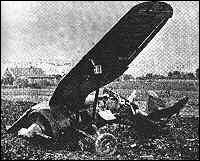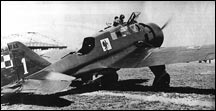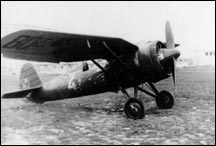| White
Knights
Poland’s Air Forces
in Third Reich/Great Pacific War
By David Meyler
November 2012
The new Polish republic of 1918, after almost
125 years of foreign domination, was created
in a virtual power vacuum. The four empires
formerly dominant in eastern Europe —
Germany, Austria, Russia and Turkey —
had disappeared. Turkey had been sheared of
almost all its non-Turkish provinces (except
for parts of Armenia and Kurdistan), and was
involved in a vicious war with Greece. The
Austrian empire had been chopped up into four
units, the republics of Austria and Czechoslovakia,
and the monarchies of Hungary and Yugoslavia.
Germany had been reduced to a state of military,
economic and industrial impotence, and was
wracked with a virtual civil war between left
and right-wing extremists. A soviet republic
had been established in Russia, but was engulfed
in brutal civil war.
For much of the previous century, Polish
nationalism had been expressed through armed
revolt, and the new state under Marshal Josef
Pilsudski had a strong militaristic leaning.
There were some Polish nationalists who wished
to go back to the borders held before the
first partition of Poland in the 1772, which
included territory in eastern Germany, the
Baltic states, Belarus and Ukraine. Polish
military glories of the grand medieval past
served as an inspiration (note the military
units named in honour of heroes such as Boleslaw
Chobry and Stefan Batory). Pilsudski himself,
under the Austrians, had led a Polish army
of exile against the Russians. Many other
leaders had served in the former imperial
German and Russian armies, or with General
Haller's Polish corps in the French army.
A fledgling air force was established in 1919
under army control, with equipment and airmen
from the French, German and Russian air services
of the 1914-18 war.
|

A myth is born. Outmoded PZL P.7 caught
on the ground, 1939.
|
The Russian civil war almost immediately spilled
over into Poland, and open war broke out over
Ukraine and Belarus. In a series of wide-ranging
campaigns, marked by rapid advances and retreats
completely unlike the static trench warfare
of western Europe, the Poles surged forward,
only to be driven from Ukraine right back to
Warsaw. Here, in 1920, the overextended Red
Army was narrowly but decisively defeated. The
Poles were also involved in a low-intensity
but still nasty war on their western frontier
against assorted German Freikorps (ad hoc military
units formed out of World War I veterans, with
a mixed monarchical and fascist membership).
The domestic situation was also filled with
tension and political factionalism, including
the assassination of the republic’s
president in 1922. In 1926, Pilsudski staged
a coup and established a military junta under
his direction, although the parliament continued
to play a minor role. After his death in 1935,
the military remained in effective control
under Marshal Eduard Rydz-Smigly. Poland played
a risky game of power politics during the
1920s and '30s, alienating Lithuania over
the city of Vilnius and participating in the
dismemberment of Czechoslovakia with Nazi
Germany.
With the catastrophic defeat of 1939, we
have tended to lose sight of the rise of Polish
influence in the period of relative calm between
1927 and 1933. The Polish army underwent a
massive modernization plan. By 1933-34, the
republic possessed one of the largest and
most modern armies in the world, with a tank
force of several hundred vehicles (larger
than Britain or Germany). The air force was
the first in the world to be equipped exclusively
with all-metal monoplane fighters (the PZL
P7a), at a time when most other air forces
still depended on biplanes. The bomber force
was based on the PZL P23 Karas. For its class
and speed (it was faster than many contemporary
fighters), the Karas carried a relatively
heavy bomb payload of 700kg. Both the P7 and
P23 were native Polish designs.
|
 The Elk’s snout. Nose gunner of
a PZL P.37 Los.
The Elk’s snout. Nose gunner of
a PZL P.37 Los.
|
But this rise in Polish prestige could not
be sustained. In part it was illusory. As
both Germany and Soviet Russia began to recover
their former power during the 1930s, they
began to exert pressure on Polish territory
once again. Poland attempted but failed to
create a Baltic bloc, based on itself and
including Lithuania, Latvia, Estonia and Finland
as a kind of counter-weight to Soviet power.
The cost of military expansion to the relatively
undeveloped Polish economy was high. All funds
spent on defence between 1935 and 1939 represented
just one-tenth of the total budget Germany
spent on its Luftwaffe in 1939 alone. Polish
equipment, tactics and strategy had been geared
to fight a one-front war against the Soviet
Union of the 1920s, in the relatively undeveloped
areas of eastern Poland. With the unexpectedly
rapid rise of Nazi Germany, the Poles found
themselves incapable of re-arming for a war
against the Germans.
By 1939, the Polish air force had fallen
far behind the Luftwaffe in numbers and, to
a lesser degree, in technology. The Poles
in Third Reich/Great Pacific War still
warrant a 2-4 TAC (using the Karas as its
icon), twice the strength of most other minor
air forces. The P11c, the replacement for
the P7, was clearly outmatched by the German
Messerschmidt Bf109E, although the Polish
plane was more manoeuvrable. On the other
hand, the P38b was an excellent design, among
the top medium bombers then in service.
|
 Beware of flying carp. A PZL P.23B Karas.
Beware of flying carp. A PZL P.23B Karas.
|
Polish equipment at the time of the German invasion
included:
PZL P7a
Hopelessly obsolete, the P7a soldiered on
in three front-line squadrons and supplied
reserve aircraft to most fighter squadrons
— a high-wing open cockpit monoplane,
two machine guns, 300 km/h.
PZL P11c
The P11 equipped 12 of Poland's 15 fighter
squadrons, and a number of earlier P11a's
were used in training and reserve units. In
general appearance and armament the P11 was
similar to the P7, but with enclosed cockpit
and more powerful engine with speed of 370km/h.
PZL P23B Karas (Carp)
A low-wing monoplane with three machine guns,
bomb load of up to 700kg, top speed of 330km/h,
the Karas was the primary Polish light attack
bomber. An advanced design for the early 1930s,
it was obsolete by 1939.
PZL P37B Los (Elk)
A twin-engined, low-wing monoplane design,
medium bomber with front glazed nacel, it
carried three machine guns, 2580 kg bombs
and top speed of 445 km/h. The Elk was one
of the most advanced medium bombers of its
day.
RWD14B Czapla (Heron)
A high-wing monoplane, open cockpit two-seater,
armed with two machine guns, 160kg bombs,
and with a speed of just 247 km/h. Originally
designed as a light bomber, the Czapla had
been largely relegated to a reconnaissance
role, although some attack squadrons still
operated the plane.
R-XIIID
This high-wing monoplane was the primary
reconnaissance aircraft along with the Czapla,
and was also used as a naval attack plane.
It was an open cockpit two-seater, armed with
two machine guns, up to 160kg bombs or a torpedo
in the attack version, with a top speed of
195 km/h.
RWD8
A high-wing monoplane, unarmed single-seater,
with a top speed of 170 km/h, the RWD8 was
used in the vital if unglamorous role of army
liaison, an especially crucial task considering
the poor state of wireless communications
in the Polish army. Flying against German
Messerschmidts, RWD8 pilots had to be among
the bravest in the Polish air force.
The frontline air force had 129 P11c (plus
43 of the earlier P11a in reserve), 30 P7a
(75 reserves), 118 P23 Karas (85 reserves),
36 P37 Los (30 reserves), 49 R-XIII (95 reserves)
and 35 RWD14 Czapla (20 reserves). Each army
and some of the individual divisional groups
(a very rough equivalent to a corps) were
each given their own air support element.
The central command meanwhile had control
of the independent fighter and bomber brigades.
This was meant to allow flexibility in aerial
operations, giving local commanders access
to immediate air support while the high command
could use its concentrated force for major
offensives. In practice, army commanders proved
reluctant to expend their own air units and
usually requested support from the Bomber
Brigade, and the resulting delays meant little
effective support could be provided. Of the
total 220 tons of bombs dropped by the Polish
air force during the September campaign of
1939, less than 20 tons were delivered by
army air support units. Eventually most of
the independent air units were concentrated
into a centralized force.
|
 Polish PZL P.11c prepares for take-off.
Polish PZL P.11c prepares for take-off.
|
The German myth that the Polish air force
had been largely wiped out on the ground on
the first day, though widely believed then
and after — making for effective propaganda
— was untrue. The more modern aircraft
had been withdrawn to secret airfields before
the invasion and those aircraft lost were
largely of little military value. For the
first week, September 1-7, Polish air units
maintained a cohesive resistance, but thereafter
order began to break down.
The fate of the Fighter Brigade serves as
an example as to what happened to Polish air
units in general. On September 8, the opening
day of the Bzura offensive (the one major
Polish counter-attack against the German armored
drive on Warsaw), only 16 out of 40 interceptors
had fuel. On the 9th, all units were moved
to the more secure region of Volhynia in eastern
Poland, but that expended all fuel reserves
and no operations could be made on the 10th.
The high command then changed its mind again,
and on September 11 ordered the brigade back
to Lublin, and again that left no fuel for
operations. On September 14, the fighters
were back in Volhynia. Then, on September
16 and 17, the brigade was re-organized into
two new fighter wings in Warsaw and Krakow
with, combined, 46 P11c's and eight P7's (used
for reconnaissance). But limited fuel supplies
allowed for only a few sorties. Thus, for
the whole of the Bzura offensive the Polish
ground units involved had virtually no air
cover. German air superiority was unchallenged.
|
 A herd of elk prepare for inspection,
1939.
A herd of elk prepare for inspection,
1939.
|
The offensive broke into two parts: From
September 8 to 12 the Poles (the Poznan and
Pomorze armies, under the direction of General
Kutrzeba, commander of the Poznan Army) smashed
the German 30th Division (September 9-10),
but did not have the mobility, even with the
support of two cavalry brigades, to effectively
exploit the gap. From September 13 to 18,
Kutrzeba’s divisions fought a desperate
battle to break out back to Warsaw to escape
an impending German encirclement. On September
9, Kutrzeba had requested fighter cover with
the commander of the fighter brigade, but
with fuel expended relocating the planes this
proved impossible to carry out.
On the whole, any kind of Polish air support
was exceptional. The Germans, in addition
to special ground attack squadrons equipped
with Henschel Hs123 biplanes and Ju87 dive
bombers, after September 10 also committed
three medium bomber wings — KG1, KG4
and KG26 (about 300 medium bombers) —
to the battle. Key targets were bridge crossings,
river fords, road junctions and troop columns.
In the climatic battles during September 16
and 17, the Luftwaffe flew uninterrupted low-level
attacks. It was an unprecedented use of air
power, something the Poles had no hope of
matching.
For a brief few days, Kutrzeba's offensive
had wrested the initiative from the Germans.
The Eighth Army's advance to the east was
halted in its tracks. The Tenth Army had to
break off its assault on Warsaw and turn its
force around 180 degrees. The assault into
the Polish capital would not be resumed until
September 25. In that respect, the Polish
attack over the Bzura River did achieve one
of its objectives in taking the immediate
pressure off the Warsaw garrison. However,
Kutrzeba had fatally underestimated the speed
with which the German motorized forces could
react, and the overwhelming impact of the
Luftwaffe.
|
 A PZL P.24 on the flight line.
A PZL P.24 on the flight line.
|
On October 5, the day Poland capitulated, the
air force had lost 327 aircraft, while 94 to
98 machines with their crews escaped to Romania.
The Luftwaffe lost 285 aircraft in combat, with
another 279 heavily damaged and written off
as irreparable. Polish aircrew in air-to-air
combat had shot down over a hundred German aircraft,
while losing less than that. The remaining Polish
losses were result of anti-aircraft fire, or
aircraft destroyed on the ground. The remnants
of Polish air units flew to Romania after September
18. From there more than 8,000 Polish pilots
assembled in France, with two fighter groups
in active service by the time of German invasion
in May 1940. After the collapse of France, a
Polish Air Force was re-established in Britain.
Nos. 320 (Poznanski) and 303 (Kosciuszko) Squadrons
(fighters) took part in the Battle of Britain
in the summer of 1940. Polish pilots claimed
203 enemy aircraft destroyed (about 7 percent
of the RAF total), with 29 Polish pilots killed.
Other crew served in Bomber Command.
Exiled Polish aircrew also saw extensive
service with the Red Air Force. By 1943, a
fighter squadron had been established and
expanded into the 1st Warsaw Fighter Regiment.
By the end of 1944, a Polish Flying Corps
was operating in support of the 2nd Polish
Army.
Order of Battle
Polish Air Force High Command Aviation
Reserve, September 1939
Fighter Brigade:
- III/1 Dyon (Wing) (111th and 112th Pursuit
Squadrons, equipped with 11 P11c fighters
each)
- IV/1 Dyon (113th and 114th Pursuit Squadrons,
each with 11 P11c)
- 123rd Pursuit Squadron (unattached unit,
equipped with ten PZL P7a fighters)
Bomber Brigade:
- II/2 Dyon (21st and 22nd Attack Squadrons,
both equipped with 11 PZL P23B Karas light
bombers)
- VI/6 (64th and 65th Attack Squadrons,
each with 11 P23B Karas)
- 56th Attack Squadron (unattached, 11 P23B
Karas)
- X/1 Dyon (211th and 212th Bomber Squadrons,
equipped with nine PZL P37B Los medium bombers
each)
- XV/1 Dyon (216th and 217th Bomber Squadrons,
each nine P37B Los)
Independent:
- 16th Reconnaissance Squadron (seven Lublin
R-XIIID reconnaissance aircraft)
- Nr. 4 and Nr. 13 Liaison Flights (each
with three RWD8 aircraft)
- Transport Squadron (nine Fokker F-VII
aircraft)
Army Karpathy (Div. Gen. K. Fabrycy) Air
Support Detachment:
- 31st Attack Squadron (11 P23B Karas)
- 56th Reconnaissance Squadron (seven R-XIIID)
- Nr. 5 Liaison Flight (three RWD8)
Army Krakow (Brig. Gen. A. Szylling)
Air Support Detachment:
- III/2 Dyon (121st and 122nd Pursuit Squadrons,
both with ten PZL P11c)
- 24th Attack Squadron (ten P23B Karas)
- 23rd Reconnaissance Squadron (seven RWD14B
Czapla)
- 26th Reconnaissance Squadron (seven R-XIIID)
- Nr. 3 Liaison Flight (three RWD8)
Army Lodz (Div. Gen. J.K. Rommel) Air
Support Detachment:
- III/6 Dyon (161st Pursuit Squadron with
12 P11c
- 162nd Pursuit Squadron with ten P7a)
- 32nd Attack Squadron (11 P23B Karas)
- 63rd Reconnaissance Squadron (seven RWD14B
Czapla)
- 66th Reconnaissance Squadron (seven R-XIIID)
- Nr. 10 Liaison Flight (three RWD8)
Army Modlin (Brig. Gen. E. Krukowicz-Predrzymirski)
Air Support Detachment:
- III/5 Dyon (comprised only the 152nd Pursuit
Squadron, ten P11c)
- 41st Attack Squadron (ten P23B Karas)
- 53rd Reconnaissance Squadron (seven RWD14B
Czapla)
- Nr. 11 Liaison Flight (three RWD8)
Army Pomorze (Div. Gen. W. Bortnowski)
Air Support Detachment:
- III/4 Dyon (141st and 142nd Pursuit Squadrons,
both equipped with 11 P11c)
- 42nd Attack Squadron (11 P23B Karas)
- 43rd and 46th Reconnaissance Squadrons
(each seven R-XIIID)
- Nr. 7 and Nr. 8 Liaison Flights (each
three RWD8)
Army Poznan (Div. Gen. T. Kutrzeba) Air
Support Detachment:
- III/3 Dyon (131st and 132nd Pursuit Squadrons
- 11 and ten P11c respectively)
- 34th Attack Squadron (seven RWD14B light
bombers)
- 33rd Reconnaissance Squadron (seven R-XIIID)
- Nr. 6 Liaison Flight (three RWD8)
Army Pruzy (Div. Gen. S. Dab-Biernacki)
Air Support Detachment:
- Nr. 1 and Nr. 2 Liaison Flights (each
three RWD8)
Naval Air Support Command:
- 1st Torpedo/Navy co-operation squadron
(ten R-XIIID floatplanes, two RVIII seaplanes)
- 1st Training Squadron (five land-based
R-XIIID)
- Naval Liaison Flight (three land-based
RWD8)
Send Poland's aerial heroes into battle!
Order Third Reich while you still can! |
